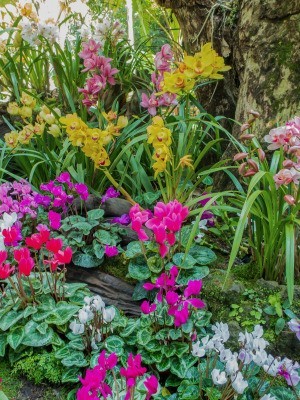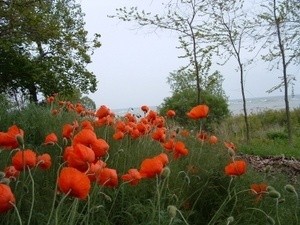
Chances are your garden has one or two areas where, despite growing successfully in other parts of the garden, plants seem to struggle. This might be due to a microclimate; a small area in your garden where the climate differs from the surrounding area due to small differences in topography. Things like hills, valleys, trees, and large bodies of water all have an influence on the growing "climate" of your plants. Once you understand the advantages and disadvantages that each type of microclimate has, you'll be better equipped to successfully meet your plant's growing requirements.
Advantages: Nutrients and topsoil regularly wash downhill from surrounding slopes making valley soil some of the richest and most fertile soil for growing plants.
Disadvantages: Cool air is heavier than warm air. It always pools and collects at the lowest point. Unfortunately, that means that garden plots located at the bottoms of valleys are usually subject to the earliest frosts in the fall, and the latest frosts in the spring. In fact, some valleys can be as much as 10 degrees cooler than nearby slopes. A lack of air circulation can also encourage conditions that support fungal diseases, especially in areas where soil lacks good drainage.
Advantages: Because warm air rises, temperatures tend to be more moderate at the tops of hills compared to the surrounding valleys or flat land. Air circulation is greater, so conditions do not favor the development of fungal diseases. In urban areas, balconies and rooftops create similar microclimates, but on a smaller scale.
Disadvantages: Whipping winds (especially in winter) can damage plants, dry out soil and cause the erosion of topsoil. Since water flows downhill, valuable organic nutrients can be quickly washed away.
Advantages: Regular breezes can help cool hot temperatures in the afternoon. The warm air that rises over them in the morning helps keep frost at bay. In northern climates, slopes with a southern exposure tend to warm up more quickly than surrounding areas in the spring and remain frost-free longer in the fall. This translates into a slightly longer growing season and potentially, a larger harvest. Raised beds and terrace gardens (especially when facing south) can create microclimates like slopes.
Disadvantages: Gardening on a steep slope can be challenging in terms of water and wind erosion (unless terraced or sheltered by windbreaks). Over time, this can result in a wearing away of valuable topsoil and a lack of soil moisture due to excessive drainage. South facing slopes warm up earlier, which can leave early blooming plants more susceptible to damage from frost.
Advantages: Water warms up and cools down at a slower rate than the land that surrounds it. As a result, large bodies of water moderate surrounding air temperatures and give you a longer growing seasons by keeping frost at bay. The larger the body of water, the greater effect it will have on the surrounding environment.
Disadvantages: Winds tend to be stronger near large bodies of water. In climates where large bodies of water freeze over completely, the spring thaw can feel like it's never going to arrive.
Advantages: Urban areas, especially large cities, can be as much as one full hardiness zone warmer than the surrounding countryside. This is because urban areas contain large amounts of paved surfaces and concrete structures that absorb heat during the day and then radiate it back into the air at night. The advantage to gardening in a large urban area is that all this radiant heat keeps temperatures moderate in the spring, winter, and fall when plants are at a greater risk of damage from extreme cold. Tall buildings also protect plants by blocking or slowing down the wind.
Disadvantages: Unfortunately, paved surfaces and tall buildings trap summer heat, which can create a blistering environment for plants during the growing season.
Thank you so much for this article. Now, a challenge - is it possible to grow salad vegetables like tomatoes and lettuce all year around OUTSIDE?
I was thinking that if I microclimated, it might work. We do get frosts, here in Warrnambool, Victoria, Australia, but no snow.
It is also very, very windy, with a fair bit of that wind coming off the Southern Ocean. Thankyou again for your wisdom. Dominus tecum
Leonie
I've developed a detailed and interactive USDA zone plant hardiness map for the continental US. This tool allows you to turn the USDA zones on and off and view the zones against a detailed google maps base map. Check it out at: www.plantmaps.com/